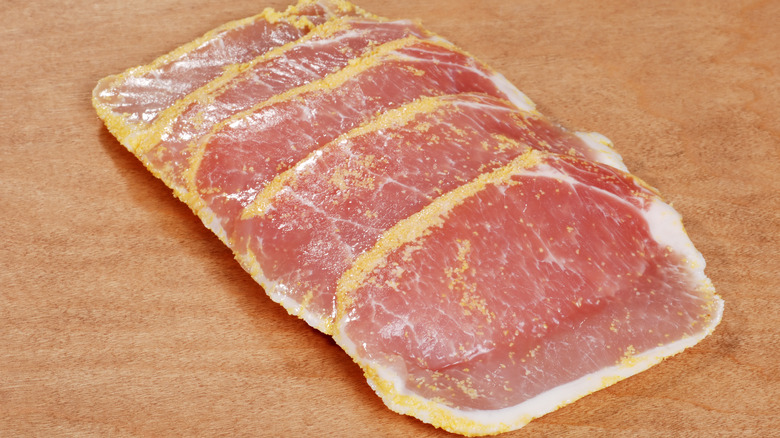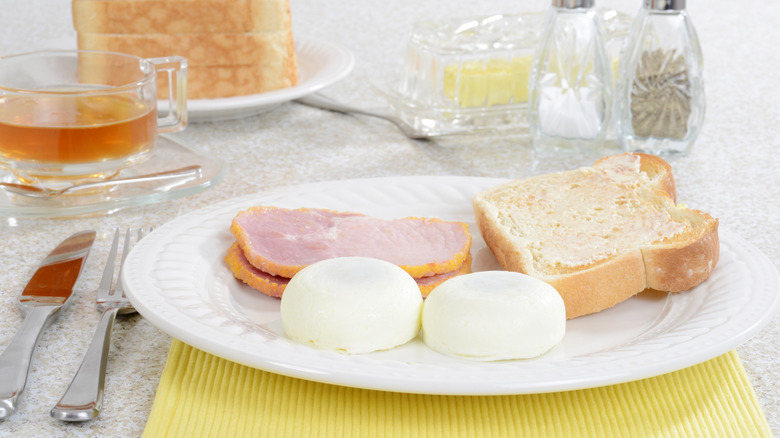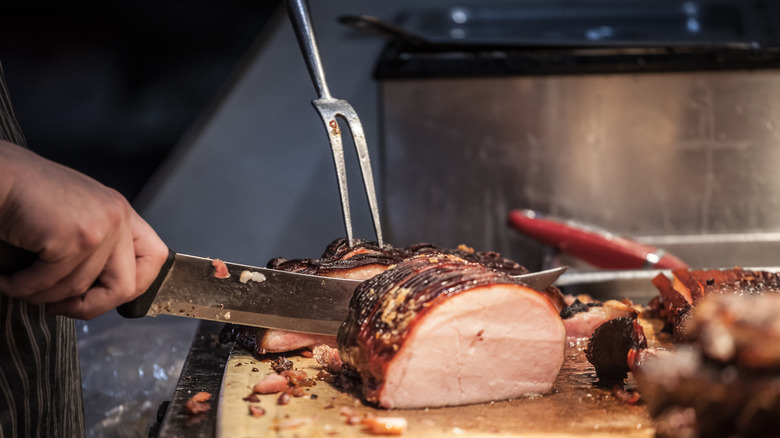Peameal Bacon: The Canadian Breakfast Food You Should Know
For most Americans, what we know as Canadian bacon is much more like ham than traditional bacon (via Kitchn). It's cut from a cured pork loin, which may or may not have been smoked. Canadian bacon is leaner than strip bacon, which comes from the fattier pork belly. Slices of Canadian bacon are round, making them the perfect size and shape for a breakfast sandwich or the classic eggs Benedict.
While we know Canadian bacon, most Americans have never heard of peameal bacon and that's a state of affairs that is worth rectifying. Pork production, processing, and curing has a long tradition in Canada, so much so that Toronto was home to the largest pork plant in all of the British Empire in the early 1900s, according to Food Network. The plant, owned by William Davies, processed about half a million hogs each year, supplying the empire with its pork and bacon and earning Toronto the nickname of Hogtown. According to Oola, peameal bacon dates back to the early 1900s and it is Davies that is purported to have developed this delicious breakfast staple in modern Canadian households.
What is peameal bacon?
Like regular Canadian bacon, peameal bacon comes from the pork loin (via Atlas Obscura). The pork loin is brined or cured, then rolled in cornmeal, which helps to keep the cured pork loin dry and preserve it longer. The name comes from the breakfast meat's historical incarnation when the cured pork loin was rolled in ground dried peas, rather than the present-day cornmeal. North Country Smokehouse, located in New Hampshire, sells and ships their peameal bacon for U.S. consumers who'd like to try it for themselves. The peameal bacon is described as "a center-cut pork loin, immersed in our infamous maple brine and rolled in cornmeal."
Peameal bacon isn't typically smoked and before the pork loin is cured, it's carefully trimmed, which Atlas Obscura explains makes the thinly sliced breakfast meat juicy and tender when it's cooked, rather than crisp, like traditional strip bacon. And peameal bacon must be cooked before serving, according to Food Network, which recommends griddling the peameal bacon, noting that the pork can also be cooked by baking, barbecuing, or roasting.
How does peameal bacon stack up nutritionally?
Typical servings of peameal bacon, Canadian bacon, and strip bacon vary enormously in their nutritional values. A typical serving size of peameal bacon, according to Nutritionix, is two slices or about 85 grams. It provides 90 calories, three grams of fat, 640 milligrams of sodium, and 12 grams of protein. Strip bacon, in a serving size of three slices (35 grams), contains 161 calories, 12 grams of fat, 581 milligrams of sodium, and 12 grams of protein, per Nutritionix. Canadian bacon's serving size is three slices (42 grams), and it has 60 calories, one gram of fat, 411 milligrams of sodium, and 12 grams of protein (via Nutritionix).
Peameal bacon can be served as a breakfast side, just as strip bacon is or it can be served on a decadent breakfast sandwich or in a dish akin to eggs Benedict. Aside from specialty U.S. producers like North Country Smokehouse, peameal bacon is found mostly in Canada. In 2016, Mayor of Toronto John Tory, named the peameal bacon sandwich the signature dish of Toronto, according to the Toronto Sun. The pork empire William Davies built in the 1900s lives on as Maple Leaf Foods, which still produces peameal bacon for Canadian consumers, per Food Network.
For those DIY-ers out there, Epicurious provides a peameal bacon recipe, which calls for a four-day-long brining period in the refrigerator. Should you undertake the production of a batch of peameal bacon, it would be an extraordinary addition to a perfect breakfast sandwich.


